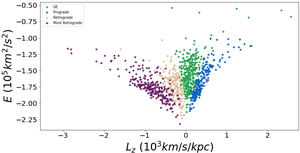
The halo of the Milky Way is an extended and roughly spherical region, sparsely populated by stars, that surrounds the Galactic disc. The halo mainly contains stars of old ages and low metal content. The orbits of these stars can be very eccentric, sometimes having high inclinations relative to the plane of the galactic disc, and some stars can have retrograde orbits (meaning that they orbit the Galaxy in the opposite direction to the rotation of the disc).
Some of these halo stars were formed in the Milky Way itself, but others were formed in smaller satellite galaxies that were swallowed up by the Milky Way throughout its history. By studying the properties of halo stars, astronomers can attempt to reconstruct the history of the formation of the Milky Way.
In a work that was recently published, two astronomers from the Nicolaus Copernicus Astronomical Centre (CAMK), André Rodrigo da Silva (PhD student) and dr. hab. Rodolfo Smiljanic (CAMK professor), used unsupervised machine learning methods to investigate the origin of 6600 old metal-poor halo stars located at distances as far as 8 kpc from the Sun.
The results show that old stars formed in the Milky Way can have very eccentric and retrograde orbits, traits often linked with stars formed in satellite galaxies that merged with the Milky Way. These peculiar orbits likely arise due to gravitational disturbances induced by prior interactions with other galaxies. Stars formed inside and outside the Milky Way can be separated on the basis of their chemical composition, particularly using the elements Al and Mn. The distinct chemical compositions reflect the different histories of chemical enrichment between small and large galaxies.
The analysis found two main groups of accreted stars. The largest group has stars with very eccentric orbits that seem to belong to Gaia-Enceladus, the last large satellite galaxy to have merged with the Milky Way about 9.6 billion years ago. The second smaller group of stars has a lower metal content. The orbits of these stars are strongly retrograde, but also less eccentric. These stars may be connected to different merger events that have been called Thamnos and Sequoia.
Finally, the correlations between abundances of the elements Eu, Mg, and Fe indicate that, for stars of Gaia-Enceladus, the heavy element europium was mostly formed by core-collapse supernovae. Contrary to expectations, no signs of Eu being produced by neutron star mergers were found.
The article, "Exploring the chemodynamics of metal-poor stellar populations", by André Rodrigo da Silva and Rodolfo Smiljanic, describing these results has been published in A&A.
This research was supported by the National Science Center through the OPUS project ``Near-UV stellar spectroscopy: uncovering the past and building the future''. See the project description.
Fig. 1: The diagram shows the orbital binding energy (E) as a function of the orbital angular momentum (Lz) for the halo stars analyzed in this work. Positive values of Lz indicate that the star orbits the Galaxy in the same direction of the rotation of the disc. Negative values of Lz indicate retrograde orbits. The higher the value of E, the easier would it be to remove the star from the Milky Way. The colours indicate the four groups defined in the analysis. In all groups 40-70% of the stars were formed in the Milky Way. The other stars were formed in dwarf galaxies that were accreted by the Milky Way in the past. Stars from the Gaia-Enceladus galaxy are found in the groups shown in blue, green, and light brown colours. In the violet group the stars have different chemical composition and probably originate in the Thamnos or Sequoia dwarf galaxies.
Text: Rodolfo Smiljanic






